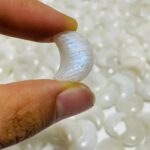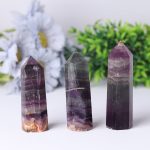With the rise in popularity of crystals for their purported healing properties and spiritual benefits, it’s important to be able to distinguish between genuine crystals and imitations. Many people may not know that not all crystals or gemstones sold in stores or online are real. Some may be man-made, treated, or even fake, which means they have been artificially created to resemble natural crystals.

Why Test Crystals for Authenticity?
Testing the authenticity of crystals is essential for several reasons:
- Ensuring the Authenticity of Healing Properties: Genuine crystals are believed to possess unique healing properties. Fake crystals may not have these properties and can hinder the desired therapeutic effects.
- Protecting Against Fraud: Imitation crystals are often sold at inflated prices, potentially leading to financial loss. Knowing how to differentiate between real and fake crystals can help protect against such scams.
- Preserving the Value of Collections: Collectors and investors highly value authentic crystals. Ensuring the authenticity of your crystal collection can protect its monetary and sentimental worth.
Common Mistakes to Avoid
Before exploring methods to test crystals, it’s important to acknowledge common mistakes to avoid:
- Relying Solely on Appearances: Color, shape, and clarity can vary even among genuine crystals. Relying solely on visual characteristics can be misleading.
- Assuming High Price Equals Authenticity: Expensive crystals do not necessarily indicate authenticity.
- Trusting Unreliable Sources: Avoid purchasing crystals from vendors who cannot provide proof of authenticity or refuse to answer questions about their products.
Step-by-Step Approach to Testing Crystals
1. Visual Inspection
-
Examine the crystal’s color. Natural crystals often exhibit variations in hue and saturation, while fake crystals may appear too perfect or uniform in color.
-
Check for inclusions. Natural crystals may contain minor imperfections or inclusions, such as bubbles or mineral deposits. Fake crystals are typically flawless.
2. Hardness Test (Mohs Scale)
-
Use a Mohs hardness pick to scratch the crystal’s surface. Real crystals will resist scratches at a specific level on the Mohs scale.
-
The Mohs scale ranges from 1 (talc) to 10 (diamond). Most genuine crystals fall between 6 (feldspar) and 8 (topaz) on the scale.
3. Refractive Index Test
-
Use a refractometer to measure the crystal’s refractive index, which is the bending of light as it passes through the material.
-
Different crystals have distinct refractive indices, which can help identify them. For example, quartz has a refractive index of 1.54, while glass has a refractive index of 1.52.
4. Density Test
-
Determine the crystal’s specific gravity by measuring its mass and volume.
-
Genuine crystals have specific densities that differ from imitations. For instance, amethyst has a specific gravity of 2.6-2.7, while amethyst-colored glass has a specific gravity of 2.4-2.5.
5. Thermal Conductivity Test
-
Use a thermal conductivity meter to measure the crystal’s ability to transfer heat.
-
Real crystals exhibit lower thermal conductivity than imitations. For example, quartz has a thermal conductivity of 0.133 W/m·K, while glass has a thermal conductivity of 0.96 W/m·K.
6. Spectroscopic Analysis
-
Subject the crystal to infrared, ultraviolet, or Raman spectroscopy to analyze its chemical composition and structure.
-
Unique spectral patterns can help distinguish genuine crystals from imitations.
How to Test Crystals for Specific Properties
Scratch Resistance Test
-
Use a hard object, such as a nail or a steel file, to attempt to scratch the crystal’s surface.
-
Genuine crystals will resist scratches more effectively than imitations.
Heat Resistance Test
-
Hold a flame near the crystal for a short time.
-
Real crystals will not melt or change color under low heat, while fake crystals may melt or discolor.
Additional Considerations
Clarity
- Real crystals may exhibit some clarity, allowing light to pass through them.
- Fake crystals may appear milky or opaque.
Luster
- Genuine crystals possess a characteristic luster or shine.
- Imitations may have a dull or artificial shine.
Electrical Conductivity
- Some crystals, such as quartz and calcite, are piezoelectric, meaning they can generate an electrical charge when subjected to pressure.
- Testing for electrical conductivity can help identify certain types of crystals.
Innovative Application: Crystal Resonance Analyzer
Crystal Resonance Analyzer (CRA) is a device that utilizes sound waves to measure the resonance frequency of crystals. Different crystals resonate at specific frequencies, providing a unique identifier for each type of crystal. CRAs are used by gemologists and crystal collectors to verify the authenticity and identify crystals accurately.
FAQs
1. Can I tell if a crystal is real by its shape?
- While some crystals have distinct shapes, relying solely on shape is not a reliable method for determining authenticity.
2. How do I know if a crystal is dyed?
- Examine the crystal under a microscope. Dyed crystals may show dye particles or uneven coloration.
3. Can a fake crystal still have healing properties?
- Fake crystals do not possess the same energetic or healing properties as genuine crystals.
4. What is the best way to ensure I am buying real crystals?
- Purchase from reputable vendors who provide proof of authenticity and warranties.
5. Can I test crystals at home using just my senses?
- While some tests can be performed at home using sight, touch, and smell, it is recommended to use scientific methods for accurate results.
6. How often should I test my crystals for authenticity?
- It is not necessary to test your crystals regularly unless you have reason to suspect they may be fake.
Conclusion
Testing crystals for authenticity is crucial to ensure the integrity of healing practices, prevent financial scams, and preserve the value of crystal collections. By employing the methods outlined in this guide, you can confidently discern genuine crystals from imitations, empowering you to experience the true benefits and beauty of crystal energy.
| Method | Principle | Equipment | Accuracy | Limitations |
|---|---|---|---|---|
| Visual Inspection | Examine color, shape, inclusions | None | Low-moderate | Can be misleading for some crystals |
| Hardness Test | Scratch resistance | Mohs hardness pick | Moderate-high | Not applicable for softer crystals |
| Refractive Index Test | Measuring light bending | Refractometer | High | Requires specialized equipment |
| Density Test | Specific gravity | Balance, graduated cylinder | Moderate | Requires precise measurements |
| Property | Test | Authentic Crystal | Fake Crystal |
|---|---|---|---|
| Scratch Resistance | Scratch with hard object | Resists scratching | Scratches easily |
| Heat Resistance | Heat with flame | No melting or discoloration | Melts or discolors |
| Transparency | Transparency | Allows light to pass through | Milky or opaque |
| Luster | Shine | Characteristic luster | Dull or artificial shine |
| Characteristic | Authentic Crystal | Fake Crystal |
|---|---|---|
| Color | Varies in hue and saturation | Too perfect or uniform |
| Inclusions | May contain bubbles or mineral deposits | Flawless |
| Hardness | Resists scratches at a specific Mohs level | Scratches easily |
| Refractive Index | Distinct refractive index | Different refractive index |
| Density | Specific gravity consistent with type | Specific gravity different from type |
| Thermal Conductivity | Low thermal conductivity | High thermal conductivity |




























